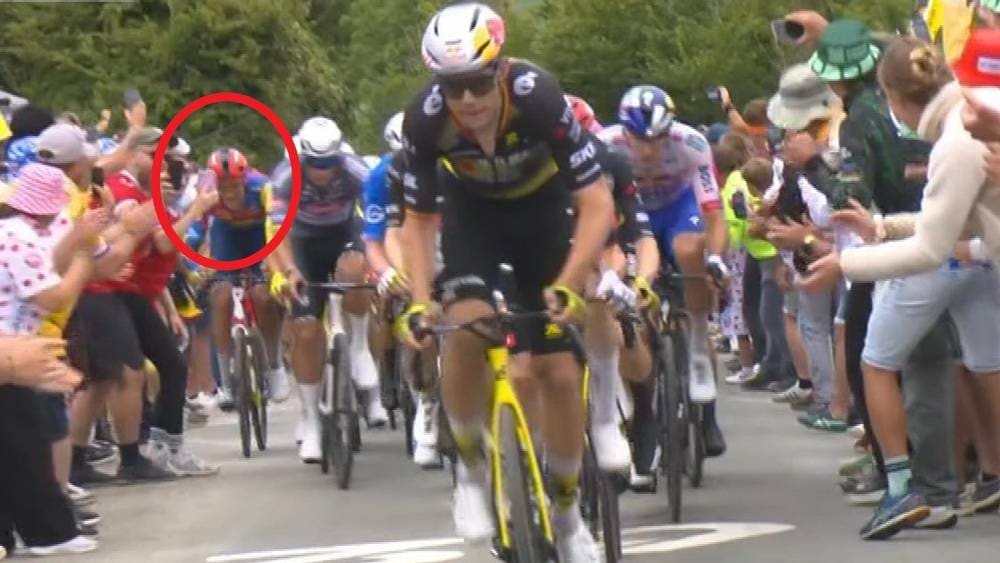Saka oppsummert:
- Former professional cyclist Mads Kaggestad urges spectators to be careful, especially by avoiding standing with their backs to the bike lane when it passes. Several riders have been hit by phones while cycling in this year’s Tour de France. Tour de France organiser ASO urges spectators to be careful, and Thor Hushovd believes spectators must take extra responsibility where there is no fence. Riders’ speeds can be extremely high, over 70 km/h during sprints, and Kaggestad believes that attitude-building work is important to prevent accidents.
– Riders can be injured for life if they take too much risk.
This is what TV 2’s cycling expert, Mads Kaggestad, tells NRK.
As a former professional cyclist, he is concerned about the safety of the riders. Safety can be jeopardized by overly eager spectators with their mobile phones in hand, looking for the perfect picture.
– My advice is to put them aside a bit. At least don’t stand with your back to take a selfie when the field passes. It’s very stupid, says Kaggestad.
MOBILE: Smartphones are everywhere, including along the Tour de France route.
Clear message to the fans
Several times during the race this year there have been incidents where spectators have come close to the riders.
During ten kilometers of the Sunday stage, Jonathan Milan, among others, was seen riding straight into a spectator’s phone, before ten kilometers later a rider had to wave away a spectator who was about to take a picture.
– It’s fantastic to see all these people along the road, but they have to stay on the side of the road, Milan told Bicisport after the stage.
GET OUT OF THE WAY: The spectator reacted quickly when the rider in front of him started waving his arm.
Get a phone in your collarbone
Also for the Norwegian riders, phones have become a theme. Jonas Abrahamsen, who is almost miraculously in the Tour de France after suffering a broken collarbone two weeks before the race, was noticed on the first stage.
– In the first stage I got a phone stuck in my collarbone, so you have to be careful, says Abrahamsen.
The Norwegian stayed on the bike in that situation, but believes it’s about respect for the riders.
– It’s just about showing respect and thinking that we’re coming at a very high speed. It’s dangerous for them and for us, he continued.
Follow the Tour de France every day on the radio.
Follow the Tour de France every day on the radio.
Tour debutant Stian Edvardsen-Fredheim notices that there are more enthusiastic people along the course than he is used to.
– It’s probably something you have to get used to, seeing someone taking a higher risk than others, he says.
Tour de France organizer ASO has made several updates on social media in recent years urging spectators to be careful.
It happened, among other things, after this incident in the Tour de France in 2021:
It happened, among other things, after this incident in the Tour de France in 2021:
Hushovd: – The audience must understand that
The team manager of the Norwegian Uno-X team is clear in his call.
– When you are a spectator on open roads where there is no fence, you have a responsibility. The audience must understand that, says Hushovd.
At the finish line and a number of critical points, fences have been set up along the roads, but on large parts of the stages there is no fence to be seen. This means there is little to prevent people along the road from leaning into the roadway.
– It’s all about common sense and common sense. But people get carried away and do stupid things, says Hushovd, adding:
– We in the field, the role models and the riders must focus on that.
– Small margins
Kaggestad believes that the proximity to the spectators is part of what makes the Tour de France unique.
– The Tour de France has relied for many years on the audience showing the riders respect. It goes very fast, and the margins are very small.
The speed in the peloton is very high, and in the mass sprints the top speed can be over 70 kilometers per hour. Kaggestad believes the riders take high enough risks, so they must stop treating the spectators on the side of the road.
– It becomes too unpredictable when they have to take into account the movements of the spectators on the side. If the spectators suddenly stick out an arm, or have a movement where they lose their balance and push the riders at the speed they are going, it is very dangerous, says Kaggestad.
SELFIE: Some selfies are taken during the Tour de France. Here it is done in a safe situation.
– Should restrictions be introduced?
– Should restrictions be introduced?
– I don’t think it’s possible to define it. We just have to do attitude-building work, and people have to get to know the cyclists and have solidarity with the situation they’re in, says Kaggestad.
PS! Monday’s stage, the third in this year’s Tour de France, was won by Tim Merlier. It follows a day with several turnovers, where the organizer also received criticism from several parties for a dangerous ending.

